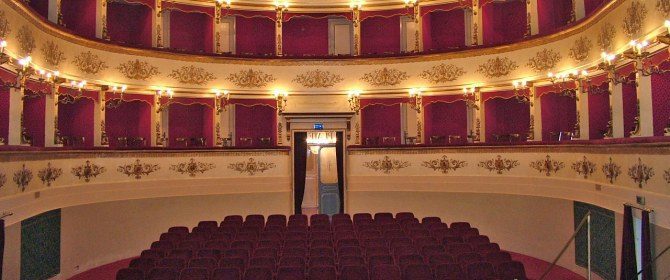Il progetto del Teatro Comunale di Gubbio (già della Fama o Condominiale), inaugurato nel 1738, venne affidato a Maurizio Lottici e Giovanni Mattioli di Parma; in seguito nel 1846 l’edificio venne in parte demolito e ricostruito per renderlo più capiente, sotto la direzione dell’ingegnere Ercole Salmi.
Il teatro ha 414 posti disponibili; al suo interno ospita decorazioni pittoriche eseguite dell’eugubino Raffaele Antonioli.
The design of the City Theatre of Gubbio (formerly della Fama or Condominiale), inaugurated in 1738, was given to Maurizio Mattioli Lottici and John of Parma, and later in 1846 the building was partly demolished and rebuilt to make it larger, thenunder the direction of engineer Hercules Psalms.
The theater has 414 seats, inside home decorations made dell’eugubino RaffaeleAntonioli.
The design of the City Theatre of Gubbio (formerly della Fama or Condominiale), inaugurated in 1738, was given to Maurizio Mattioli Lottici and John of Parma, and later in 1846 the building was partly demolished and rebuilt to make it larger, thenunder the direction of engineer Hercules Psalms.
The theater has 414 seats, inside home decorations made dell’eugubino RaffaeleAntonioli.
The design of the City Theatre of Gubbio (formerly della Fama or Condominiale), inaugurated in 1738, was given to Maurizio Mattioli Lottici and John of Parma, and later in 1846 the building was partly demolished and rebuilt to make it larger, thenunder the direction of engineer Hercules Psalms.
The theater has 414 seats, inside home decorations made dell’eugubino RaffaeleAntonioli.
The design of the City Theatre of Gubbio (formerly della Fama or Condominiale), inaugurated in 1738, was given to Maurizio Mattioli Lottici and John of Parma, and later in 1846 the building was partly demolished and rebuilt to make it larger, thenunder the direction of engineer Hercules Psalms.
The theater has 414 seats, inside home decorations made dell’eugubino RaffaeleAntonioli.


Comment (0)